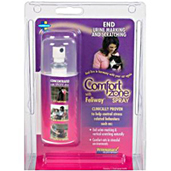One of the greatest challenges of cat
ownership is dealing with a pet that urinates or defecates outside of
the litter box. Most cats are hardwired to select a spot with
a loose substrate to use as a "bathroom." This is why cats
and kittens need little training in litter box use. Just show
them where it is and they'll take it from there. Unfortunately,
much can go wrong from this point forward.
"If your cat is acting sick in any way (e.g., straining to urinate) or if you try to address his behavior without success, see your veterinarian."
Spraying Versus Inappropriate Urination
If you are finding urine outside of
the litter box, your first job is to determine if your cat or cats are
spraying or urinating. These are two very different behaviors
with unique underlying causes and treatments; making this distinction
is very important.
When a cat sprays, he usually stands in front of
a vertical surface (e.g., a wall) and squirts a relatively small amount
of urine on it. He may rapidly vibrate his tail while he is doing
this. Spraying is a form of marking behavior. Therefore,
male cats, especially those that have not been neutered, are more likely
than females to spray, and the risk increases in multiple cat households.
When a cat urinates outside of the
litter box, he or she will usually squat and leave a puddle of urine
on a horizontal surface (e.g., the floor or bed). Cats that choose
to urinate or defecate around the house often dislike something about
their litter boxes. Common problems include:
- A dirty and smelly box that is cleaned infrequently
- A change in the type of litter used
- Litters that contain a lot of perfumes
- Boxes with high sides that are difficult to get in or out of, especially for older, arthritic cats
- Covered boxes that are dark and "claustrophobic" or difficult to move around in
- A bad experience in or around the litter box (e.g., being attacked by another cat)
Given enough time, a cat that urinates
or defecates on a material other than cat litter will start to feel
that this is normal behavior. It can be difficult to get these
cats to start using cat litter again, so try to address problems with
litter box use quickly.
Veterinary Care and Home Treatment

Keep in mind that illness or injury
can change urination or defecation habits. If your cat is acting
sick in any way (e.g., straining to urinate) or if you try to address
his behavior without success, see your veterinarian. To
rule out medical problems, your vet will need to perform a physical
exam, get a complete history of your cat's behavior, and maybe run
blood work, a urinalysis, fecal examinations, x-rays and other diagnostic
tests.
If your cat has been given a clean
bill of health, behavioral modification is the next step. To eliminate
spraying, try to reduce any conflicts that are making your cat feel
like he has to mark his territory. In a multi-cat household, provide
lots of elevated perches, hiding places and covered escape routes so
that pets have a way to avoid each other when they want to. Draw the
drapes or blinds if an indoor cat is bothered by animals outside the
home.
Anti-anxiety
medications, supplements, and sprays,
diffusers or wipes like Comfort Zone that
help calm cats will often improve the situation if all else fails.
If your cat routinely sprays in the same location, cover the area with
foil. Most cats do not like the sound of a stream of urine hitting
foil. And thoroughly clean
up any areas that have
been soiled with urine with a product like Urine-Off. The smell can encourage more marking behavior.
Making litter boxes more attractive
is the key to correcting inappropriate urination or defecation.
First clean up all soiled areas with a product that eliminates the smell of cat urine and
feces. Then, try the following:
- Always have one more litter
box than the number of cats in the house.
- Provide large, uncovered
boxes filled with a deep layer of unscented litter containing activated
charcoal or your cat's favorite litter.
- Scoop out the boxes once
or twice a day and dump, wash and fill them with clean litter once a
month.
- Initially, place litter
boxes over the areas that have been soiled and then gradually move them
to where you want them.
- Consider using a litter box attractant.
The above is provided for information purposes only and should not be used for the diagnosis or treatment of any condition.
This information does not cover all possible variables, conditions, reactions, or risks relating to any topic, medication, or product and should not
be considered complete. Certain products or medications may have risks and you should always consult your local veterinarian concerning the treatment of
your pet. Any trademarks are the property of their respective owners.